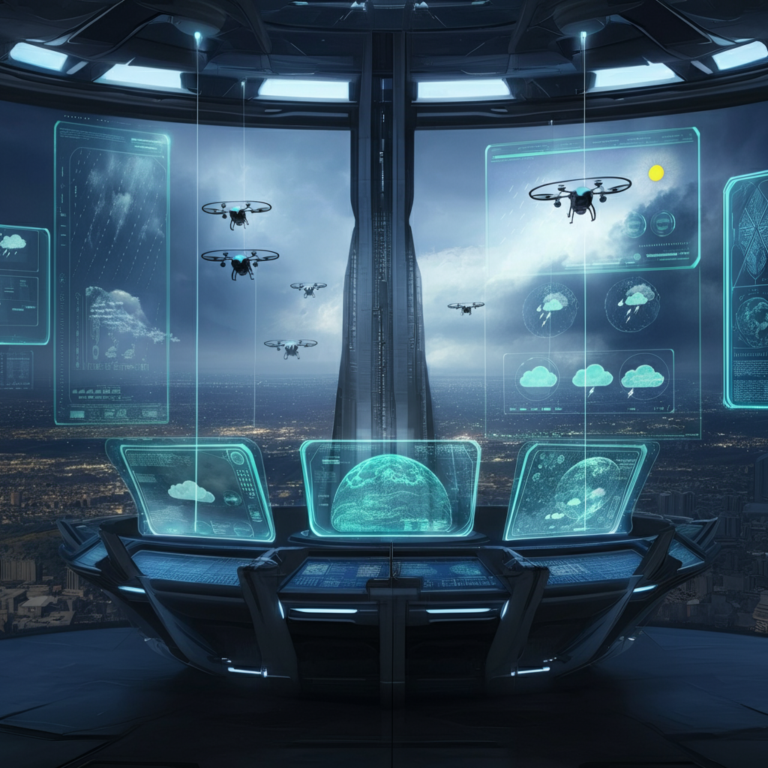For as long as we’ve walked this Earth, humanity has watched the skies with awe, fear, and wonder. The weather, a powerful force that shapes our crops, cities, and history, has always seemed untouchable—until now. But what if that weren’t the case? What if we could control the very winds, summon rain, or banish storms? For fans of science fiction and speculative thinking, the concept of controlling the weather blurs the lines between sheer imagination and a scientific future on the horizon.
Programming the Skies in Science Fiction
The idea of controlling the weather has been a recurring fascination in science fiction for over a century. Authors and filmmakers alike have often woven this concept into tales of power, ingenuity, and sometimes, disaster.
Take H.G. Wells’ The Shape of Things to Come (1933), where futuristic governments shape the climate to build utopia—or in darker interpretations, dystopia. Or consider Ray Bradbury’s short story “The Long Rain,” which vividly explores mankind’s struggle against unyielding weather on the planet Venus. From desert planets to rain-drenched alien worlds, controlling weather has symbolized our desire to tame nature.
Popular media has more recently capitalized on this theme, rolling out blockbusters like Geostorm, where humans develop weather satellites capable of managing natural disasters—until, of course, things go terribly wrong. These narratives often present weather manipulation as a double-edged sword, a dream that may spiral into a nightmare if mishandled.
But what if there’s truth behind the fiction? What technologies or frameworks could really allow us to master the elements?
Theoretical Frameworks for Weather Control
We may not have weather-wielding satellites—yet—but the science behind controlling the weather is becoming less fictional every day. A concept rooted in meteorology, physics, and even nanotechnology, the idea often starts with altering microclimates before tackling planetary-scale systems.
Cloud Seeding
One of the most well-known technologies in this realm is cloud seeding, a method used to encourage rainfall by dispersing substances like silver iodide into clouds. Already a reality, cloud seeding has been used in China, the United States, and the UAE to coax precipitation in dry areas. However, its scale and predictability remain limited.
Geoengineering
On a grander scale is the concept of geoengineering, where emerging technologies aim to influence the climate as a whole. Techniques like stratospheric aerosol injection (SAI) are being explored to reflect sunlight and cool the Earth, reducing the effects of climate change. Bold? Yes. Risky? Absolutely. Critics say such technologies come with unpredictable environmental side effects.
Advanced Algorithms and AI Monitoring
Future weather control could also involve sophisticated AI systems capable of analyzing atmospheric patterns and using predictive models. These algorithms might suggest the best interventions, from creating controlled rain to mitigating hurricanes. Though still a work in progress, these systems could push weather control closer to being an actionable reality.
However, even as we brainstorm technologies to control the weather, looming shadows of ethical, social, and environmental questions threaten to rain on our parade.
The Heavyweight Questions of Ethics and Power
With great power comes… you know the rest. The prospect of controlling the weather unleashes a torrent of ethical dilemmas.
Weather control might amplify global inequalities. What happens when countries with advanced technologies start altering rainfall patterns in their favor? Could one nation’s desire for snow impact another’s access to water? Conflicts over how these tools are wielded could fuel a new era of geopolitical tension.
Furthermore, tampering with the climate raises concerns about triggering unintended consequences. How would altering a storm on one continent ripple across the globe? Scientists may meticulously plan outcomes, yet nature, as we know, has a tendency to defy expectations.
From an environmental standpoint, the big question remains—should we interfere? Some argue humans should focus on reducing their environmental impact rather than manipulating nature on a larger scale. Others say such technology is humanity’s best shot to counteract the damage we’ve already inflicted.
The implications are endless—and troubling. But looking to the real world, humanity has already begun dipping its toes into weather experiments, many of which serve as precursors to full-blown weather control.
Real-World Applications of Weather Manipulation
Though not quite the sci-fi spectacle seen in books or movies, weather manipulation is already happening on small, tangible scales.
Cloud Seeding Experiments
Take cloud seeding, for instance. The state of Wyoming uses it during winters to enhance snowpack in the mountains, ensuring enough water during the spring thaw. The UAE has even deployed drones spraying tiny electric charges into clouds to produce rainfall—an incredible fusion of engineering and meteorology.
Hurricane Mitigation
Researchers are also exploring ways to disrupt hurricanes before they reach land. Some proposals include cooling ocean temperatures to weaken these powerful storms. While experimental, such plans could save lives and prevent devastation if executed successfully.
Agricultural Interventions
Rain guarantees harvests, and harvests keep the world fed. Governments and private organizations are investigating localized weather interventions to combat droughts and secure food supplies. While limited in scope, these uses hint at broader, global applications that could reshape agriculture altogether.
Even so, these measures, as innovative as they are, come with limitations. Success isn’t guaranteed, and weather manipulation remains an imperfect art at best.
Weather Control and the Human Psyche
The cultural fascination with weather control reflects our deeper relationship with nature. For eons, humans have lived subject to the unpredictability of rain, thunder, and winds—forces utterly oblivious to human will. Science fiction’s continued exploration of controlling the weather underscores a collective yearning to overcome that helplessness.
But there’s also a psychological duality in these stories—our ambition paired with an intrinsic reverence for nature. The disasters in Geostorm or comic-book chaos of Storm (X-Men) are not mishaps but warnings. They suggest that attempts to dominate weather are as much about hubris as they are about progress.
And isn’t that what makes this idea so seductive? Weather control isn’t just about rain or sunshine. It’s about changing the rules of survival itself.
Is the Future Sunny or Cloudy?
Weather control hovers on the edge of science fact and fiction. On one hand, technologies like AI and geoengineering hint at brighter prospects where humans tame droughts, mitigate hurricanes, and combat global warming. On the other, ethical landmines and environmental risks suggest paths riddled with uncertainty.
For science fiction enthusiasts, this intersection of reality and imagination teases endless storytelling possibilities—a testament to humanity’s boundless curiosity and caution. Whether as a dream or a warning, weather control serves as a reminder of our relationship with the natural world and the responsibilities that come with great power.
And so, as we gaze at the clouds above, perhaps the greater question isn’t “what if we could?” but instead, “what should we do if we can?”







